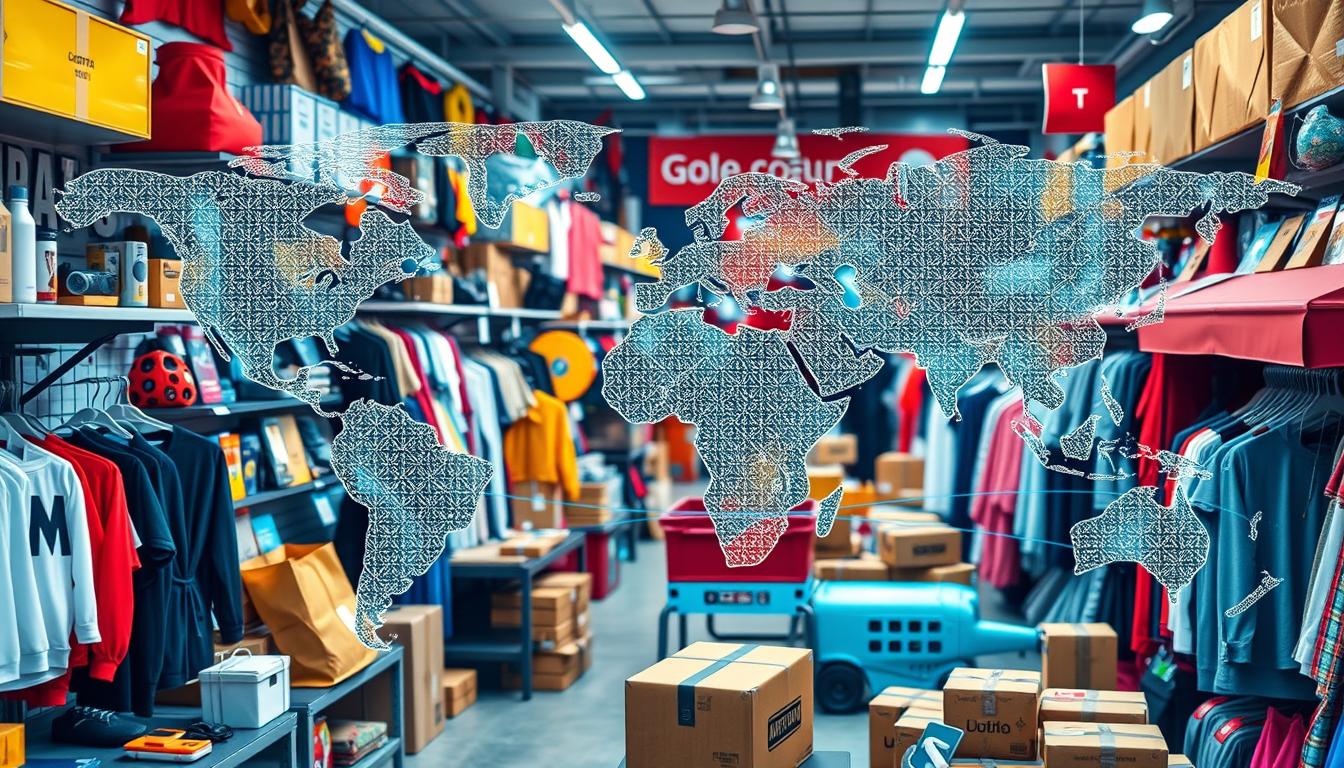In the world of ecommerce, dropshipping is a big hit. It lets you run an online store without dealing with inventory or shipping. This makes it great for those who want to start a business without spending a lot1.
Dropshipping means you promote products and manage your store online. Meanwhile, a supplier takes care of the products, from getting them to shipping them to your customers1. This way, you can focus on marketing and customer service while the supplier handles the rest1.
If you’re good at marketing and want to start a business with little money, dropshipping is for you. You just need a laptop and internet to begin. It’s a great way for new entrepreneurs to get started1.
Key Takeaways
- Dropshipping is an order fulfillment model where you sell products without managing inventory or shipping.
- This business model allows you to start an ecommerce business with minimal investment.
- As a dropshipper, you focus on marketing, customer service, and growing your business, while the supplier handles the physical fulfillment.
- Dropshipping is a flexible and accessible option for entrepreneurs with strong marketing skills.
- The low startup costs and lack of need for physical space make dropshipping an attractive choice for those looking to start an online business.
Understanding the Dropshipping Business Model
Dropshipping lets you sell products without keeping them in stock. When a customer buys something, you buy it from a supplier. Then, the supplier ships it directly to the customer2. This model is great because it has low startup costs and can be set up quickly2.
What Is Dropshipping?
In dropshipping, you’re the seller, setting prices and handling sales tax2. The process is simple: 1) You partner with a dropshipper, 2) a customer buys from your store, 3) you send the order to the dropshipper, and 4) they ship it to the customer3.
How Does Dropshipping Work?
Dropshipping lets you try new products easily2. But, it can be hard to stand out since others might sell the same things2. To do well, you need to show you can make money and have a good relationship with suppliers2. Knowing how much your supplier can sell is also key2.
Dropshipping can grow through SEO and more people finding your store2. A free tool can tell you how much your store is worth2.
“Dropshipping is an ecommerce strategy where products are sold without keeping them in stock, with the supplier shipping products directly to the customer.”3
The dropshipping market is growing fast, expected to hit $476.1 billion by 20263. It already makes over $300 billion in sales each year3. But, making money in dropshipping can be tough because of thin profit margins2.
Dropshipping is good for beginners, those testing new products, or adding items without big investments4. But, it might not be the best for growing a brand or making lots of money4.
| Dropshipping Advantages | Dropshipping Disadvantages |
|---|---|
| Low startup costs | Thin profit margins |
| Flexibility and freedom to explore new products | Potential competition selling the same products |
| Wide product selection | Reliance on supplier’s fulfillment capabilities |
In summary, dropshipping is a low-cost, flexible way to sell lots of products without managing inventory. But, it has its challenges like thin profit margins and competition. Knowing the pros and cons is key for entrepreneurs234.
Benefits of Dropshipping for New Entrepreneurs
Dropshipping is a great choice for new business owners. It has many benefits that make it appealing. One big plus is the low cost to start. Dropshippers don’t have to store or ship products, so they can start an online store with little money5.
Many dropshipping businesses start from home. They need only a good internet connection and a laptop5.
Dropshipping also offers a lot of freedom. You can run your business from anywhere with internet. This means you can work from home or travel5.
This model makes starting an ecommerce business easy. Dropshippers don’t have to deal with warehouses, inventory, or shipping5.
Wide Product Selection
Dropshipping lets new entrepreneurs sell many products without buying them first5. This way, they can try different products and see what sells best without spending a lot of money5.
It also means no costs for making products. Dropshippers can find products ready to ship from suppliers5.
“Dropshipping simplifies the process of starting an ecommerce business by removing the need for managing warehouses, inventory, and order fulfillment.”5
Dropshipping has its downsides, like lower profits and shipping issues6. But, its benefits like low costs, flexibility, and a wide range of products make it a good choice for new entrepreneurs5. By using dropshipping, new business owners can explore retail arbitrage and product sourcing with less risk and more flexibility.
Challenges Faced by Dropshippers
Dropshipping is attractive to new entrepreneurs, but it comes with challenges. Dealing with unreliable suppliers, shipping issues, and keeping profits up is tough. Even experienced dropshippers find it daunting.
Supplier Reliability
Finding a supplier that matches your brand is a big worry for dropshippers7. A Partner and Fulfillment Manager at Channel Engine says this is the biggest hurdle7. It’s hard to ensure quality, timely delivery, and good customer service with third-party suppliers.
Shipping and Handling Issues
Dropshipping works best with low-cost items like consumables7. Some 3PLs need a certain order volume to be cost-effective7. Moving goods quickly from supplier to fulfillment center is key to avoid stockouts and keep customers happy7.
It’s important to tell customers how long shipping will take. Dropshipping doesn’t always mean faster delivery, as transit and last-mile times stay the same7.
Margins and Pricing
Keeping profit margins healthy is a big challenge for dropshippers8. Building a brand is hard with mass-produced products, making it tough to get noticed8. Price changes from suppliers can hurt profits, and sudden price changes are a risk8.
An automated price monitoring tool helps manage these changes. It lets dropshippers adjust prices quickly to keep margins up8.
Dropshipping businesses face many hurdles, from finding reliable suppliers to keeping profits high8. But, with strategies like a customizable website, smart marketing, and tools for inventory and price management, they can overcome these challenges. This way, they can succeed in the fast-paced e-commerce world8.
“The number one challenge faced by dropshippers is finding a fulfillment provider that aligns with their brand standards.”
– A Partner and Fulfillment Manager at Channel Engine
Choosing the Right Niche for Dropshipping
Finding the right niche is key to a successful dropshipping business. The niche you pick shapes your target audience and guides your product choices. There are two main ways to pick a profitable niche:
Popular Niches to Consider
- Choose a niche you know well or love. This makes it easier to find and sell products that meet your customers’ needs. Studies show that products for passionate hobbyists, like mountain biking or fishing, can lead to high spending.9
- Look at market demand to pick a niche. Use tools like Google Trends and Keywords Everywhere to find what people are searching for. Google Trends helps understand search trends and patterns, helping you spot market shifts.9
- Check online marketplaces like Amazon and AliExpress for top-selling items. This helps you see what’s popular and how to price your products. Online marketplaces are great for finding trending products and understanding competition.9
- Consider niches with high profit margins, like accessories. Accessories often have high profit margins and appeal to customers who are less price-sensitive.9
Tools for Market Research
Doing deep market research is vital to find a profitable niche. Use tools like Meta Audience Insights, Google Keyword Planner, and Google Trends to learn about your market. The dropshipping market is expected to hit over $1.2 trillion by 2030, with fashion making up a big chunk.10 By knowing your market and what’s trending, you can choose a niche that fits your business goals and has good potential for success.

| Metric | Value |
|---|---|
| Global market value of dropshipping in 2022 | $225.99 billion10 |
| Projected global market value of dropshipping by 2030 | Over $1.2 trillion10 |
| Global wall art market value in 2021 | $48.50 billion10 |
| Projected global wall art market value by 2028 | $72.61 billion10 |
Finding Reliable Suppliers
Finding reliable suppliers is key to a successful dropshipping business. Luckily, many directories and platforms can help. DSers for AliExpress, AutoDS, Zendrop, and Spocket connect you with thousands of products from trusted suppliers worldwide11.
When looking at suppliers, consider product quality, shipping times, and customer service. Ordering samples can show if a supplier is reliable. For suppliers overseas, look for those that offer fast shipping like ePacket from China12.
Directories and Platforms to Use
- Inventory Source: Provides access to over 230 suppliers11.
- Salehoo: Offers a supplier directory with over 8,000 companies and 75 product categories11.
- Worldwide Brands: Supplier directory with over 8,000 suppliers, requiring a $299 lifetime membership fee11.
- Spocket: Advertises that 60 percent of their suppliers are located in the US or Europe11.
- Printful: Ships all products from the US with a focus on print-on-demand items11.
- Oberlo: A popular dropshipping app for Shopify users11.
- Dropified: Allows sourcing from different dropship suppliers, including US-based Aliexpress suppliers11.
Evaluating Supplier Credibility
Assessing supplier credibility is vital when sourcing products. Check their reviews, response times, and order fulfillment history. Building a strong relationship with suppliers can also help your business grow12.
| Supplier | Product Selection | Shipping Origin |
|---|---|---|
| AliExpress | Over 100 million products13 | China |
| Worldwide Brands | More than 16 million certified wholesale products13 | Global |
| Zendrop | Access to over a million products13 | US warehouses |
| Modalyst | Luxury and trendy brands13 | Worldwide (excluding South America and Africa) |
| Wholesale Central | Over 60 US-based dropshipping suppliers13 | US |
| Spocket | Suppliers from the US, Europe, Australia, and Brazil13 | Global |
| Megagoods | Consumer electronics13 | US (California) |
| CJDropshipping | Millions of listings from 1688 and Taobao13 | China |
| Wholesale2b | Apparel, toys, and accessories13 | US and Canada |
| Doba | Over 2 million products from 160+ suppliers13 | Global |
“Finding the right supplier is crucial in dropshipping, with suppliers being a vital part of the business’s foundation and success.”12
Setting Up Your Online Store
Creating an ecommerce store is key for dropshipping. Shopify and others offer tools to build your store with themes and checkout systems14. Make sure to include product pages and content like reviews and guides. Also, don’t forget to optimize for SEO15.
You can start a dropshipping store with little to no upfront cost. This makes it a great choice for starting an online business15.
Choosing the Right E-commerce Platform
When picking a platform for your dropshipping store, look at cost, customization, and tools. Shopify and Wix have affordable plans under $40 a month. This helps startups start their online store without breaking the bank15.
These platforms also let you customize your store with themes and plugins. This can make your site look good and work well, improving the shopping experience for your customers14.
Essential Features for Your Store
To make a successful dropshipping store, focus on a good shopping experience. Create product pages and add content like reviews and guides. This builds trust and authority with your customers15.
Also, make sure your store is easy to find online. Use search engine optimization to attract more visitors15. Start with low-cost ads on social media to save on advertising costs15.
Choosing a specific niche can help you attract more customers. Pick suppliers based on their product range, return policies, shipping areas, and support15.
By using the tools from top ecommerce platforms, you can create a store that looks good and works well. This meets the needs of your dropshipping customers14.
Developing a Marketing Strategy
To succeed in the competitive dropshipping world, a solid marketing strategy is key. Use social media to connect with potential customers and highlight your products. TikTok videos can get nearly 8 million organic views,16 and Instagram meme pages benefit from a 4:1 content-to-promo ratio16.
Email marketing is a major sales driver for dropshippers16. Send targeted campaigns to keep leads engaged and encourage more buys. Also, work on SEO to boost your website’s visibility and attract customers looking for your products. SEO efforts can take 6-12 months to show results16.
Boost your reach with paid ads on Google and Facebook17. With over 400 million users on Pinterest16, it’s a great platform to add to your marketing plan.
A well-rounded marketing strategy that includes social media, email, SEO, and paid ads is vital. It drives traffic, sales, and helps build a thriving dropshipping business.
“Effective marketing is the lifeblood of any dropshipping business. Stay ahead of the curve by leveraging the latest trends and tactics to reach your target audience.”
Managing Customer Service in Dropshipping
Exceptional customer service is key to a successful dropshipping business, even if you don’t handle orders18. Keeping customers informed at every step builds trust and loyalty. Make sure to have a clear system for handling returns and refunds, working closely with suppliers for a smooth experience18.
Importance of Good Communication
In dropshipping, clear communication is essential19. Customers want quick updates and service, aiming for responses within two hours19. Use social media to understand what customers want, improving satisfaction and loyalty19. Have customer service available 24/7 to keep response times low and customer experience high19.
Handling Returns and Refunds
Clear return and refund policies are vital for dropshipping businesses18. A survey by Ecommerce Foundation shows 67% of shoppers expect clear policies18. Make sure your return and refund process is smooth, working with suppliers to keep customers happy18. Offer detailed shipping info and FAQs on your site to answer common questions and improve the shopping experience19.
Exceptional customer service is crucial for dropshipping success18. Focus on clear communication, efficient returns and refunds, and solving problems quickly. This will help you build a loyal customer base and stand out from competitors18.

“Satisfied customers are the best business strategy of all.” – Michael LeBoeuf
Investing in customer service can greatly benefit your dropshipping business20. Studies show that two-thirds of businesses compete on customer service, earning up to 8% more revenue20. Also, 61% of consumers have higher customer service expectations, making it even more important to meet these expectations20.
By focusing on quick communication, easy returns and refunds, and customer satisfaction, you can achieve long-term success in the competitive retail arbitrage and third-party logistics markets181920.
Tools and Software for Dropshipping Success
Starting a dropshipping business? You can use many tools and software to make it easier. These tools help manage your inventory and shipping. They make your business run smoother and more efficiently.
Inventory Management Systems
Managing your inventory well is key in dropshipping. Systems like Oberlo, AliDropship, and Ecomdash help track stock levels. They also update stock in real-time and sync orders21.
Shipping and Fulfillment Tools
Good shipping and fulfillment are crucial for success. Tools like Spocket, SaleHoo, and Syncee automate orders and track them in real-time. They also work well with your online store21.
For more advanced needs, consider paid tools like Inventory Source, Zik Analytics, and DSM Tools. They offer better inventory management and help you find products and set prices21.
When picking tools, think about your budget and how complex your business is. Free tools like Oberlo are great for beginners. Paid tools offer more features and support for growing businesses21.
| Tool | Pricing | Key Features |
|---|---|---|
| DSers | $19.9 to $499 per month | Basic free version, paid plans with AliExpress cashback and advanced features |
| AutoDS | $24 per month, 30-day trial for $1 | Shopify and Wix integration, automated order fulfillment |
| Dropified | $19 or $47 per month, 14-day free trial | Product research, automated order fulfillment, supplier integration |
| Inventory Source | $99 to $150 per month, limited free features | Supplier and inventory management, order automation |
| Spocket | $39.99 to $299 per month, up to 8 months free on annual payment | Supplier network, product sourcing, order fulfillment |
The dropshipping world is changing fast, with AI playing a big role. AI tools help with market research, inventory management, and order fulfillment. This leads to happier customers and more loyalty21.
Starting your dropshipping journey? Look into the many tools and software out there. They can help you grow your business and build strong customer relationships. With these tools, you can succeed in the fast-paced world of dropshipping212223.
Scaling Your Dropshipping Business
As your dropshipping business grows, it’s key to focus on strategies for expansion and streamlining. You can diversify products and automate processes to scale your ecommerce venture. This will drive sustainable growth24.
Strategies for Growth
Expanding your product lines is a great way to scale. Offering more items can attract a wider customer base and boost sales24. Also, consider entering new markets or segments that fit your brand and expertise. This can reach new audiences and fuel growth24.
Improving operational efficiency is another crucial strategy. Automating tasks like order fulfillment and customer service can save time and resources. This lets you scale more effectively25. Diversifying your supplier network also reduces risks and ensures product availability, aiding in scaling25.
Automating Your Processes
Automation tools are a game-changer for scaling your dropshipping business. Solutions that streamline order processing, inventory management, and customer communication boost efficiency25. Partnering with a dropshipping agent can also help with tasks like product sourcing and order fulfillment. This frees up time for strategic growth25.
As you scale, analyzing performance data and making informed decisions is vital. Use A/B testing, monitor key metrics, and adjust marketing strategies and supplier relationships. This optimizes profitability and long-term sustainability25.
By using these strategies and automating processes, you can set your dropshipping business up for scalable growth. This will ensure success in the competitive ecommerce landscape2425.
Future Trends in Dropshipping
The dropshipping world is changing fast. New trends are coming, thanks to what customers want and new tech. These changes bring both challenges and chances for smart dropshippers.
Evolving Customer Preferences
Today, people want fast delivery, green products, and shopping that feels personal. The dropshipping market is expected to grow to $1,253.79 billion by 2030, with a 23.4% growth rate26. Dropshippers must focus on quick shipping, offer green products, and use data to make shopping personal.
The Role of Technology in Dropshipping
Technology will be key in the future of dropshipping. AI and machine learning will change how we forecast, serve customers, and work efficiently27. New tech like AR will let customers try products virtually and see them in 3D27. Also, new social commerce sites and marketplaces will give dropshippers more ways to sell26.
To stay on top, watch the trends, adjust your plans, and use tech to wow customers. By doing this, your dropshipping business can thrive in the fast-changing online world.
FAQ
What is dropshipping?
How does the dropshipping process work?
What are the advantages of dropshipping for new entrepreneurs?
What are the challenges of dropshipping?
How do I choose a profitable dropshipping niche?
How do I find reliable dropshipping suppliers?
What features should my dropshipping store have?
How do I market my dropshipping business effectively?
How do I provide good customer service in a dropshipping business?
What tools can help me streamline my dropshipping operations?
How can I scale my dropshipping business?
What are the emerging trends in the dropshipping industry?
Source Links
- What Is dropshipping? How does it work in 2024? – https://sell.amazon.com/learn/what-is-dropshipping
- The Dropshipping Business Model Explained – https://empireflippers.com/dropshipping-business-model-explained/
- What Is Dropshipping: The Ultimate Guide [Updated for 2024] – https://www.oberlo.com/blog/what-is-dropshipping
- Understanding Dropshipping – https://www.salehoo.com/learn/understanding-dropshipping
- What Is Dropshipping and How Does It Work? (2025) – Shopify – https://www.shopify.com/blog/what-is-dropshipping
- Dropshipping: Does It Actually Work? (Pros + Cons) | BigCommerce – https://www.bigcommerce.com/blog/dropshipping/
- No title found – https://dclcorp.com/blog/shipping/challenges-of-dropshipping/
- Dropshipping Challenges – Top 10 List & How To Overcome Them – https://www.autods.com/blog/dropshipping-tips-strategies/dropshipping-challenges/
- How To Find the Best Dropshipping Niches in 2024 – Shopify – https://www.shopify.com/blog/dropshipping-niches
- Best dropshipping niches to grow your business in 2024 – https://www.gelato.com/blog/profitable-dropship-niches
- How To Find (& get approved with) Dropship Suppliers – https://www.inventorysource.com/dropshipping/how-to-find-dropship-suppliers/
- Council Post: How To Find Dropshipping Suppliers – https://www.forbes.com/councils/forbesbusinesscouncil/2021/12/06/how-to-find-dropshipping-suppliers/
- 14 Best Dropshipping Suppliers in 2025 – Shopify – https://www.shopify.com/blog/dropshipping-suppliers
- Shopify Dropshipping – The Complete Updated Guide For 2024 – https://www.autods.com/blog/dropshipping-tips-strategies/shopify-dropshipping-tutorial/
- Setting up your Dropshipping Store in 7 Steps on a Budget – https://www.modalyst.co/blog/start-drop-shipping-store-budget/
- 10 Profitable Dropshipping Marketing Strategies For 2024 – https://blog.dropcommerce.com/posts/dropshipping-marketing-strategies
- 7 Tips For Creating a Bulletproof Dropshipping Marketing Strategy in 2024 – https://dropshipping.com/article/dropshipping-marketing-strategy/
- Tips for Excellent Customer Service As a Dropshipper – https://www.inventorysource.com/tips-for-excellent-customer-service-as-a-dropshipper/
- Customer Service For Dropshipping: 9 Customer Service Tips – https://www.bluecart.com/blog/customer-service-dropshipping
- Improving Customer Service For Dropshipping: 9 Best Practices In 2024 – https://www.sparkshipping.com/blog/customer-service-best-practices
- 12 Top AI Tools for Dropshipping in 2025 – Free and Paid – https://www.inventorysource.com/top-ai-tools-for-dropshipping-free-and-paid/
- Dropshipping Automation Software: 11 Tools That Help You! – https://dodropshipping.com/dropshipping-automation-software/
- 11 Best Dropshipping Software in 2025 – Shopify – https://www.shopify.com/blog/dropshipping-software
- Scale Without Fail: 6 Steps To Grow Your Dropshipping Business – https://www.sparkshipping.com/blog/6-steps-to-grow-your-dropshipping-business
- How to Scale a Dropshipping Business in 2023: The Ultimate Guide – https://nichedropshipping.com/how-to-scale-dropshipping-business/
- The Future of Dropshipping: Trends, Predictions, and Stats – https://appscenic.com/blog/the-future-of-dropshipping-trends-predictions-and-stats/
- Future Of Dropshipping: Trends & Opportunities – https://www.autods.com/blog/dropshipping-tips-strategies/future-of-dropshipping/


